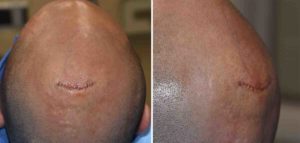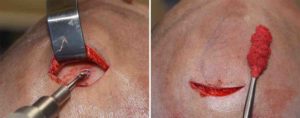Background: The sagittal suture is the fibrous connection between the two parietal skull bones running down the midline of the head. It remains as a soft tissue connection until the second or third decide of life when it closes and disappears. Premature closure of the suture in utero or early after birth results in the well known scaphocephaly condition or sagittal craniosynostosis. Skull growth is inhibited perpendicular to the suture and, as a result, the head becomes very elongated and narrow in width shortly after birth.
The sagittal suture connects anteriorly with the coronal sutures whose interface is known as the anterior fontanelle early after birth and later as the bregma when the soft spot closes. The sagittal suture connects posteriorly with the lambdoid sutures which is known as the posterior fontanelle in the first few years of life and later as the lambda when the fontanelle closes.
In some individuals a raised sagittal crest develops along the original line of the sagittal suture. It is usually highest just in front of the lambda and decreases in height coming forward towards the bregma. This is known as the posterior sagittal crest deformity. A line may be seen coming all the forward to the forehead but the highest point is in the back, making the skull height highest at the back end of the sagittal suture rather at the vertex in the middle portion of the suture lines.
The posterior sagittal crest deformity is an aesthetic skull deformity that is seen exclusively in men in my experience. This is probably because it becomes an issue for treatment when hair loss occurs and men shave their heads. It appears as a distinct triangular point in the front view and gives the head a midline peaked appearance.


The posterior sagittal crest represents one part of the sagittal suture that closed just a bit early but not enough to create the full blown expression of sagittal craniosynostosis. It always affects the back part of the sagittal suture with lesser degrees of bone height coming forward. It is effectively reduced by a bone burring reduction. It is important to wash out all bone dust created and to seal any bleeding vessels in the bone with wax to ensure reactive bone formation done not occur.
Highlights:
- The posterior sagittal crest represents a microform of sagittal craniosynotosis that partially affects just one part of the suture.
- Burring reduction of the raised part of the suture line is done through a small scalp incision.
- The raised sagittal crest represents thicker bone so complete reduction of it is usually possible.
Dr. Barry Eppley
Indianapolis, Indiana




